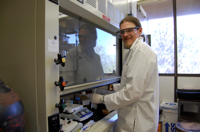
University:
Major:
Mentor(s):
Faculty Sponsor(s):
Faculty Sponsor's Department:
Project Title:
Project Description:
Nontoxic adhesives sticking under aqueous conditions are not available at present, but would offer new applications like the treatment of bone fractures. To create such a material biology is mimicked, to be exact: the adhesion of mussels to underwater surfaces via complex coacervation. One crucial detail of adhesion is the spreading of the surface. Complex coacervates are considered because they coat wet surfaces due to low surface tension. In our research we focused on component-specific magnetic resonance methods to probe the local dynamics of the coacervates. Apart from that UV-vis spectroscopy was used to determine the turbidity of the sample which is proportional to the coacervation; so we could correlate the dynamical properties with the extent of coacervation. We attached spin labels to either one of the species to make the measurements component-specific. In order to probe polymer chain rigidity we used Electron Spin Resonance (ESR). In further experiments we will use Dynamic Nuclear Polarization (DNP) to obtain the water dynamics within a 5 Å of the sample. Strikingly, ESR of spin labeled, coacervated HA suggests no immobilization. In contrast, the ESR spectra with spin labeled mfp 151 show a restricted mobility of the protein when coacervated. The HA seems to provide a viscous yet flexible environment for rigid chains of mfp151. We now have to further investigate the properties of this system using DNP experiments.
